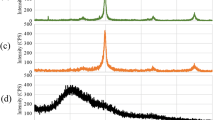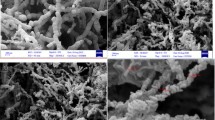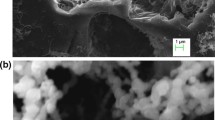Abstract
Statistical optimization of performance determining factors is essential for the development of a cesium removal system from aqueous solutions. Therefore, factorial experimental design and multiple regression techniques were employed to assess the primary and interaction effects of the pH, initial concentration, and contact time in the cesium removal process using nanoscale zero-valent iron-zeolite (nZVI-Z) and nano-Fe/Cu-zeolite (nFe/Cu-Z) as an adsorbent. The optimum region of cesium removal was identified by constructing a contour plot. The study revealed that initial concentration was the most significant factor followed by contact time. The study also suggested that maximum cesium removal occurred at pH, initial concentration, and contact time of 6, 200 mg/L, and 30 min, respectively. Moreover, the statistically significant interaction effect was observed between contact time and initial concentration. The experimental data were also fitted with Tόth, Langmuir, Dubinin-Astakhov (D-A), Freundlich, and Hill models and found that the Tόth model fitted better compared with the other four models based on Akaike information criterion (AIC) and root-mean-square deviation (RMSD). The findings of this paper can undoubtedly contribute to constructing the optimum statistical process of removing hazardous pollutants from the water, which significantly impacts on human health and the environment.

Graphical abstract












Similar content being viewed by others
Data availability
The datasets used and analyzed during the current work are available from the corresponding author on reasonable request.
Abbreviations
- A :
-
Level of pH (−)
- a 0 :
-
Lower level of pH (−)
- a 1 :
-
Higher level of pH (−)
- AB:
-
Interaction effect between pH (−) and initial concentration (mg/L)
- AC:
-
Interaction effect between pH (−) and contact time (min)
- ABC:
-
Interaction effect among pH (−), initial concentration (mg/L), and contact time (min)
- B :
-
Initial concentration (mg/L)
- b 0 :
-
Lower level of initial concentration (mg/L)
- b 0t :
-
Equilibrium constant of Tόth model (L/mg)
- b 1 :
-
Higher level of initial concentration (mg/L)
- BC:
-
Interaction effect between initial concentration (mg/L) and contact time (min)
- C :
-
Contact time (min)
- c 0 :
-
Lower level of contact time (min)
- c 1 :
-
Higher level of contact time (min)
- C e :
-
Equilibrium concentration (mg/L)
- E :
-
Adsorption characteristic energy (J/mol)
- K D :
-
Hill constant (−)
- K f :
-
Freundlich constant ((mg/g) (mg/L)− (1/n))
- K L :
-
Langmuir constant (L/mg)
- n :
-
Heterogeneity parameter (−)
- n H :
-
Binding interaction coefficient of the Hill model (−)
- N :
-
Number of observations (−)
- Q :
-
Isosteric heat of adsorption (J/mol)
- q e :
-
Instantaneous uptake (mg/g)
- q m :
-
Maximum uptake (mg/g)
- R :
-
Universal gas constant (J/(mol/K))
- AIC:
-
Akaike information criterion
- Adj MSS:
-
Adjusted mean sum of squares
- Adj SS:
-
Adjusted sum of squares
- ANOVA:
-
Analysis of variance
- Coef.:
-
Coefficients
- Conc.:
-
Initial concentration
- Cr (VI):
-
Hexavalent chromium
- Cs:
-
Cesium
- D-A:
-
Dubinin-Astakhov
- DF:
-
Degrees of freedom
- Fe/Cu-Z:
-
Nano-Fe/Cu-zeolite
- F-value:
-
Value of F-statistic
- nZVI:
-
Nanoscale zero-valent iron
- nZVI-Z:
-
Zero-valent iron nanoparticle-zeolite
- P value:
-
Probability value
- RMSD:
-
Root-mean-square deviation
- R 2 (adj):
-
Adjusted R2
- SE coef.:
-
Standard error of coefficient
- Sr:
-
Strontium
- T-value:
-
Value of student T-statistic
- W cal :
-
Calculated cesium removal using model (mg/g)
- W exp :
-
Experimental cesium removal (mg/g)
- γ-PGA:
-
poly-γ-glutamic acid
- α :
-
Level of significance (−)
- ρ c :
-
Density of cesium (mg/L)
- τ :
-
Average removal of cesium (mg/g)
- Κ 0 :
-
Overall mean (mg/g)
- Κ i :
-
Regression coefficients (−)
References
Akaike H (1969) Fitting autoregressive models for prediction. Ann Inst Stat Math 21:243–247. https://doi.org/10.1007/BF02532251
Alby D, Charnay C, Heran M, Prelot B, Zajac J (2018) Recent developments in nanostructured inorganic materials for sorption of cesium and strontium: synthesis and shaping, sorption capacity, mechanisms, and selectivity—a review. J Hazard Mater 344:511–530. https://doi.org/10.1016/j.jhazmat.2017.10.047
Ambashta RD, Sillanpää M (2010) Water purification using magnetic assistance: a review. J Hazard Mater 180:38–49. https://doi.org/10.1016/j.jhazmat.2010.04.105
Aoyama M, Tsumune D, Inomata Y, Tateda Y (2020) Mass balance and latest fluxes of radiocesium derived from the Fukushima accident in the western North Pacific Ocean and coastal regions of Japan. J Environ Radioact 217:106206. https://doi.org/10.1016/j.jenvrad.2020.106206
Awual MR, Yaita T, Miyazaki Y, Matsumura D, Shiwaku H, Taguchi T (2016) A reliable hybrid adsorbent for efficient radioactive cesium accumulation from contaminated wastewater. Sci Rep 6:2–11. https://doi.org/10.1038/srep19937
Cabranes M, Leyva AG, Babay PA (2018) Removal of Cs+ from aqueous solutions by perlite. Environ Sci Pollut Res 25:21982–21992. https://doi.org/10.1007/s11356-018-2283-9
Can MY, Yildiz E (2006) Phosphate removal from water by fly ash: factorial experimental design. J Hazard Mater 135:165–170. https://doi.org/10.1016/j.jhazmat.2005.11.036
Chan LS, Cheung WH, Allen SJ, McKay G (2012) Error analysis of adsorption isotherm models for acid dyes onto bamboo derived activated carbon. Chin J Chem Eng 20:535–542. https://doi.org/10.1016/S1004-9541(11)60216-4
Dietz ML, Horwitz EP, Rhoads S et al (1996) Extraction of cesium from acidic nitrate media using macrocyclic polyethers: the role of organic phase water. Solvent Extr Ion Exch 14:1–12. https://doi.org/10.1080/07366299608918323
Ding D, Zhang Z, Lei Z, Yang Y, Cai T (2016) Remediation of radiocesium-contaminated liquid waste, soil, and ash: a mini review since the Fukushima Daiichi Nuclear Power Plant accident. Environ Sci Pollut Res 23:2249–2263. https://doi.org/10.1007/s11356-015-5825-4
Durrant CB, Begg JD, Kersting AB, Zavarin M (2018) Cesium sorption reversibility and kinetics on illite, montmorillonite, and kaolinite. Sci Total Environ 610–611:511–520. https://doi.org/10.1016/j.scitotenv.2017.08.122
Echeverría JC, Zarranz I, Estella J, Garrido JJ (2005) Simultaneous effect of pH, temperature, ionic strength, and initial concentration on the retention of lead on illite. Appl Clay Sci 30:103–115. https://doi.org/10.1016/j.clay.2005.03.006
Eljamal O, Shubair T, Tahara A, Sugihara Y, Matsunaga N (2019) Iron based nanoparticles-zeolite composites for the removal of cesium from aqueous solutions. J Mol Liq 277:613–623. https://doi.org/10.1016/j.molliq.2018.12.115
Favre-Réguillon A, Dumont N, Dunjic B, Lemaire M (1997) Polymeric and immobilized crown compounds, material for ion separation. Tetrahedron 53:1343–1360. https://doi.org/10.1016/S0040-4020(96)01072-1
Geyikçi F, Büyükgüngör H (2013) Factorial experimental design for adsorption silver ions from water onto montmorillonite. Acta Geodyn Geomater 10:363–370
Ghaedi AM, Panahimehr M, Nejad ARS, Hosseini SJ, Vafei A, Baneshi MM (2018) Factorial experimental design for the optimization of highly selective adsorption removal of lead and copper ions using metal organic framework MOF-2 (Cd). J Mol Liq 272:15–26. https://doi.org/10.1016/j.molliq.2018.09.051
Gossuin Y, Colet JM, Roch A, Muller RN, Gillis P (2002) Cesium adsorption in hydrated iron oxide particles suspensions: an NMR study. J Magn Reson 157:132–136. https://doi.org/10.1006/jmre.2002.2581
Han B, Chakraborty A (2020) Advanced cooling heat pump and desalination employing functional UiO-66 (Zr) metal-organic frameworks. Energy Convers Manag 213:112825. https://doi.org/10.1016/j.enconman.2020.112825
Kosaka K, Asami M, Kobashigawa N, Ohkubo K, Terada H, Kishida N, Akiba M (2012) Removal of radioactive iodine and cesium in water purification processes after an explosion at a nuclear power plant due to the Great East Japan Earthquake. Water Res 46:4397–4404. https://doi.org/10.1016/j.watres.2012.05.055
Lee KY, Kim KW, Park M, Kim J, Oh M, Lee EH, Chung DY, Moon JK (2016) Novel application of nanozeolite for radioactive cesium removal from high-salt wastewater. Water Res 95:134–141. https://doi.org/10.1016/j.watres.2016.02.052
Pal A, El-Sharkawy II, Saha BB et al (2016) Experimental investigation of CO2 adsorption onto a carbon based consolidated composite adsorbent for adsorption cooling application. Appl Therm Eng 109:304–311. https://doi.org/10.1016/j.applthermaleng.2016.08.031
Pal A, Kil HS, Mitra S, Thu K, Saha BB, Yoon SH, Miyawaki J, Miyazaki T, Koyama S (2017) Ethanol adsorption uptake and kinetics onto waste palm trunk and mangrove based activated carbons. Appl Therm Eng 122:389–397. https://doi.org/10.1016/j.applthermaleng.2017.04.099
Pal A, Uddin K, Rocky KA, Thu K, Saha BB (2019) CO2 adsorption onto activated carbon–graphene composite for cooling applications. Int J Refrig 106:558–569. https://doi.org/10.1016/j.ijrefrig.2019.04.022
Pedhazur EJ, Schmelkin LP (1991) Measurement, design, and analysis: An integrated approach. Psychology Press. ISBN-13: 978-0-8058-1063-9
Ponnusami V, Krithika V, Madhuram R, Srivastava SN (2007) Biosorption of reactive dye using acid-treated rice husk: factorial design analysis. J Hazard Mater 142:397–403. https://doi.org/10.1016/j.jhazmat.2006.08.040
Rahman MM, Pal A, Uddin K, Thu K, Saha BB (2018) Statistical analysis of optimized isotherm model for Maxsorb III/ethanol and silica gel/water pairs. Evergreen 5:1–12. https://doi.org/10.5109/2174852
Rahman MM, Muttakin M, Pal A et al (2019) A statistical approach to determine optimal models for IUPAC-classified adsorption isotherms. Energies 12:4565. https://doi.org/10.3390/en12234565
Rocky KA, Pal A, Moniruzzaman M, Saha BB (2019) Adsorption characteristics and thermodynamic property fields of polymerized ionic liquid and polyvinyl alcohol based composite/CO2 pairs. J Mol Liq 294:111555. https://doi.org/10.1016/j.molliq.2019.111555
Saadat S, Karimi-Jashni A (2011) Optimization of Pb (II) adsorption onto modified walnut shells using factorial design and simplex methodologies. Chem Eng J 173:743–749. https://doi.org/10.1016/j.cej.2011.08.042
Saha SK, Haque ME, Islam D, Rahman MM, Islam MR, Parvin A, Rahman S (2012) Comparative study between the effect of Momordica charantia (wild and hybrid variety) on hypoglycemic and hypolipidemic activity of alloxan induced type 2 diabetic long-Evans rats. J Diabetes Mellit 02:131–137. https://doi.org/10.4236/jdm.2012.21022
Saleh TA, Adio SO, Asif M, Dafalla H (2018) Statistical analysis of phenols adsorption on diethylenetriamine-modified activated carbon. J Clean Prod 182:960–968. https://doi.org/10.1016/j.jclepro.2018.01.242
Sangvanich T, Sukwarotwat V, Wiacek RJ, Grudzien RM, Fryxell GE, Addleman RS, Timchalk C, Yantasee W (2010) Selective capture of cesium and thallium from natural waters and simulated wastes with copper ferrocyanide functionalized mesoporous silica. J Hazard Mater 182:225–231. https://doi.org/10.1016/j.jhazmat.2010.06.019
Seki Y, Seyhan S, Yurdakoc M (2006) Removal of boron from aqueous solution by adsorption on Al2O3 based materials using full factorial design. J Hazard Mater 138:60–66. https://doi.org/10.1016/j.jhazmat.2006.05.033
Shakir K, Sohsah M, Soliman M (2007) Removal of cesium from aqueous solutions and radioactive waste simulants by coprecipitate flotation. Sep Purif Technol 54:373–381. https://doi.org/10.1016/j.seppur.2006.10.006
Shibata A, Koma Y, Ohi T (2016) Estimation of the inventory of the radioactive wastes in Fukushima Daiichi NPS with a radionuclide transport model in the contaminated water. J Nucl Sci Technol 53:1933–1942. https://doi.org/10.1080/00223131.2016.1196625
Shubair T, Eljamal O, Tahara A, Sugihara Y, Matsunaga N (2019) Preparation of new magnetic zeolite nanocomposites for removal of strontium from polluted waters. J Mol Liq 288:111026. https://doi.org/10.1016/j.molliq.2019.111026
Sun K, Woo C, Lee K et al (2017) Highly efficient removal of radioactive cesium by sodium-copper hexacyanoferrate-modified magnetic nanoparticles. Colloids Surfaces A Physicochem Eng Asp 516:375–382. https://doi.org/10.1016/j.colsurfa.2016.12.052
Takahashi A, Kitajima A, Parajuli D, Hakuta Y, Tanaka H, Ohkoshi SI, Kawamoto T (2016) Radioactive cesium removal from ash-washing solution with high pH and high K+-concentration using potassium zinc hexacyanoferrate. Chem Eng Res Des 109:513–518. https://doi.org/10.1016/j.cherd.2016.02.027
Ungdro R, Casnati A, Ugozzoli F, Pochini A, Dozol JF, Hill C, Rouquette H (1994) 1,3-Dialkoxycalix [4] arenecrowns-6 in 1,3-Alternate conformation: cesium-selective ligands that exploit cation-arene interactions. Angew Chemie Int Ed 33:1506–1509. https://doi.org/10.1002/anie.199415061
Wang W, Zhou M, Mao Q, Yue J, Wang X (2010) Novel NaY zeolite-supported nanoscale zero-valent iron as an efficient heterogeneous Fenton catalyst. Catal Commun 11:937–941. https://doi.org/10.1016/j.catcom.2010.04.004
Author information
Authors and Affiliations
Contributions
Md. Matiar Rahman: conceptualization, formal analysis, methodology, software, writing-original draft. Shamal Chandra Karmaker: data collection, formal analysis, investigation. Animesh Pal: investigation, methodology, writing-review & editing. Osama Eljamal: investigation, writing-review & editing. Bidyut Baran Saha: conceptualization, investigation, writing-review & editing, supervision.
Corresponding author
Ethics declarations
Conflict of interest
The authors declare that they have no conflict of interest.
Consent to participate
All authors agreed with the content and gave clear consent to submit.
Consent to publish
Not applicable.
Additional information
Responsible Editor: Tito Roberto Cadaval Jr
Publisher’s note
Springer Nature remains neutral with regard to jurisdictional claims in published maps and institutional affiliations.
Rights and permissions
About this article
Cite this article
Rahman, M.M., Karmaker, S.C., Pal, A. et al. Statistical techniques for the optimization of cesium removal from aqueous solutions onto iron-based nanoparticle-zeolite composites. Environ Sci Pollut Res 28, 12918–12931 (2021). https://doi.org/10.1007/s11356-020-11258-1
Received:
Accepted:
Published:
Issue Date:
DOI: https://doi.org/10.1007/s11356-020-11258-1




